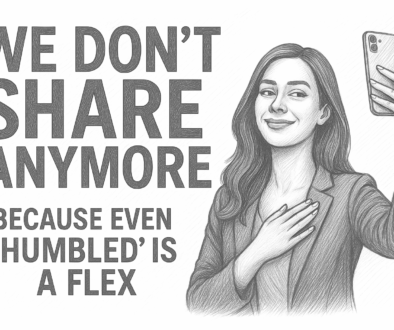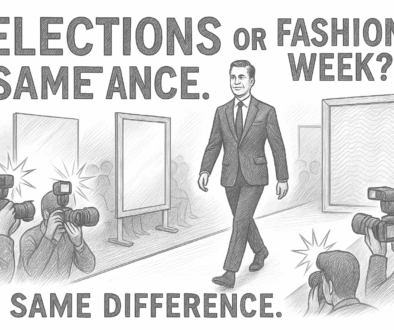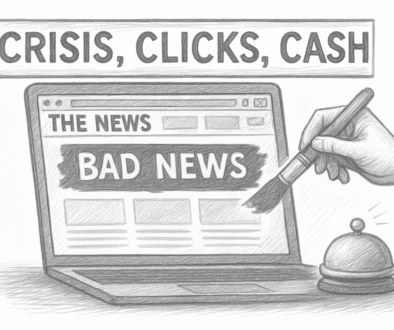Hey evolutionary misfits—
Some brands evolve. Most just mutate. And the difference between the two?
Survival.
In the natural world, evolution is adaptive. It’s a response to the environment. But mutation? It’s random. It’s the business equivalent of slapping a TikTok account on a B2B software firm because “everyone’s doing it.”
Welcome to the age of Digital Darwinism, where tech moves faster than strategy, and survival isn’t guaranteed by innovation — but by relevance.
The Law of the Jungle Is Now the Law of the Feed
Evolution doesn’t reward the strongest or smartest. It rewards the most adaptable. And in marketing, adaptability doesn’t mean chasing trends — it means responding to user behavior, technological shifts, and cultural context with intention.
Blockbuster. In 2000, they laughed Netflix out of the room. In 2010, they were bankrupt. Not because streaming killed them overnight — but because they failed to adapt while their customers did.
It’s never the comet. It’s always the inertia.
Mutation Marketing: A Dangerous Game of Brand Roulette
We see it every day: brands mimicking each other like confused parrots. Suddenly, everyone’s “disruptive,” using the same shade of blue, writing like Duolingo, and putting “AI” in places it has no reason to be.
That’s not evolution. That’s panic-induced mutation.
A McKinsey study in 2023 found that 61% of rebrands failed to improve customer perception.
Why? Because they weren’t strategic responses.
They were stylistic overhauls without ecosystem thinking. If you’re just re-skinning your brand without re-thinking your relevance, you’re not evolving.
You’re molting.

Kodak vs. Fujifilm
Let’s rewind to the early 2000s. Both Kodak and Fujifilm were dominant forces in the film photography world, staring down the barrel of digital disruption.
Kodak had the upper hand in brand recognition. They even invented the digital camera back in 1975 — and shelved it to protect their film business. Their corporate DNA was deeply tied to physical film, and their internal culture was allergic to cannibalizing it.
Fujifilm, on the other hand, saw the writing on the wall and treated digital not as a threat but as a signpost. They invested heavily in R&D and diversified, leveraging their core capabilities in chemicals and imaging into medical diagnostics, regenerative medicine, and cosmetics (see: their successful skincare line Astalift). By 2012, they had cut their film business down to just 1% of total revenue — and thrived.
Kodak filed for bankruptcy in 2012. Fujifilm grew.
It’s not that one had better tech. It’s that one had the cultural flexibility to adapt — and the strategic foresight to redefine itself.
Both giants. Both hit by the rise of digital photography. One died. The other pivoted.
Kodak clung to film like a security blanket. Fujifilm, meanwhile, leveraged their chemical expertise to branch into cosmetics, pharmaceuticals, and healthcare imaging. Today, Fujifilm is thriving.
Same threat. Different reaction. Different outcome.
Evolution is not about protecting the old. It’s about leveraging what’s core to adapt to what’s next.
Your Org Chart Is Fighting Evolution
It’s tempting to think evolution is a matter of tools. Better software, new platforms, smarter automation. But what if the real obstacle to evolution isn’t your stack — it’s your structure?
Most companies are built like machines: hierarchical, rigid, optimized for repeatability. But digital ecosystems are more like organisms — fluid, messy, adaptive. And when a machine meets an organism, guess who bends?
Legacy org charts are the biggest blockers to adaptive change. Why? Because they’re designed to preserve stability, not embrace flux. Consider how ideas travel inside a traditional company: a junior UX researcher has a brilliant insight from user testing. That insight needs buy-in from a PM, who needs approval from a director, who then waits on quarterly alignment from the brand VP. By the time it gets greenlit, the customer behavior has already changed.
According to a 2023 Capgemini report, companies with highly siloed structures were 42% less likely to complete digital transformation initiatives compared to those with cross-functional teams and flatter hierarchies.
Even when companies talk about agility, they often just repackage old structures with new terminology. “Squads” that still need director approval aren’t agile. They’re theatre.
And let’s not forget the human layer: job titles as identity, turf wars over brand ownership, resistance to anything that threatens legacy metrics. These aren’t just annoyances — they’re evolutionary handbrakes.
If your org chart rewards maintaining the status quo, you’re not set up to evolve.
You’re set up to ossify.

What Evolutionary Brands Actually Do
- They experiment with intent — Testing isn’t about novelty. It’s about feedback loops
- They hire anthropologists, not just analysts — Data shows you what. Anthropology shows you why.
- They invest in internal evolution — It’s not just the brand. It’s the mindset.
- They question legacy success — What worked five years ago might be the anchor today.
Look at Spotify: continuous redesigns, regional personalization, and AI-curated listening that adjusts to your mood.
That’s brand evolution in real-time.
Checklist: Are You Evolving or Just Twitching?
Think of this as your brand’s evolutionary stress test — a diagnostic to understand whether you’re adapting with purpose or just convulsing at every passing trend. Mutation is easy. Evolution is hard. Let’s find out where you stand.
- Do you have a test-and-learn loop integrated into marketing? Not just A/B testing banners, but systemic loops that influence product, communication, and UX? Brands like Booking.com run thousands of experiments weekly — what’s your volume?
- Are you tracking cultural shifts — not just industry trends? It’s easy to follow what competitors do. It’s harder (and more valuable) to decode cultural codes and shifts in user sentiment. Are you tuning into Reddit, TikTok, and Discord — or just reading LinkedIn posts?
- Is your design changing with user behavior or despite it? Figma’s rise wasn’t just because of design tools — it aligned with how distributed teams work. Is your design evolving from user input, or is it dictated by the latest Dribbble trends?
- Do your values evolve or just your color palette? Rebrands often change the visuals, but keep dated slogans and outdated tone. Patagonia evolved their messaging with climate urgency — have you evolved yours?
- Are your KPIs driving relevance or just performance? Are you tracking Net Promoter Score without understanding what drives it? Do you know why your bounce rate is high or just that it is?
The goal isn’t to tick boxes. It’s to trigger honest reflection. Because evolution requires discomfort. Mutation just needs panic.
and the winner is…
Brands don’t go extinct because the market changed.
They go extinct because they didn’t.
In the age of Digital Darwinism, clarity beats chaos, strategy beats novelty, and intentional evolution beats blind mutation.
Until next time, stay adaptive.
Alex
Want your brand to evolve, not just mutate?
Let’s work together to build strategies that survive the next wave.
👉 KREDO is Here!



